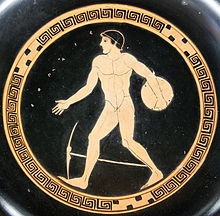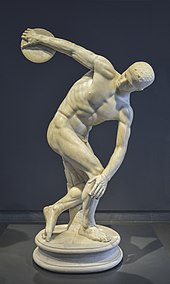Discobolus


The Discobolus by Myron ("discus thrower", Greek: Δισκοβόλος, Diskobólos) is an ancient Greek sculpture completed at the start of the Classical period in around 460–450 BC that depicts an ancient Greek athlete throwing a discus. Its Greek original in bronze lost, the work is known through numerous Roman copies, both full-scale ones in marble, which is cheaper than bronze,[1] such as the Palombara Discobolus, the first to be recovered, and smaller scaled versions in bronze.
A norm in Ancient Greek athletics, the Discobolus is presented nude. His pose appears unnatural to a human and is considered as per modern standards a rather inefficient way to throw the discus.[2]
Myron's skill is evident in his ability to convey a sense of movement of the body at the moment of its maximum tension and splendor within a static medium, transforming a routine athletic activity into a representation of balance and harmony. Myron is often credited with being the first sculptor to master this style. However, the great effort of the athlete is not reflected in his facial expression, which displays only a tenuous concentration. The torso shows no muscular strain, even though the limbs are outflung. The other trademark of Myron embodied in this sculpture is how well the body is proportioned: the symmetria. The athlete's body demonstrates a sense of proportion, with meticulous attention to detail in every muscle and sinew, capturing the dynamics of a thrower's physical actions. The contrapposto stance, subtly shifting the athlete's weight from one leg to the other, imparts a semblance of motion and adds an element of realism to the artwork. The potential energy expressed in this sculpture's tightly wound pose, expressing the moment of stasis just before the release, is an example of the advancement of Classical sculpture from Archaic sculpture.
As Clark observed, "Myron has created the enduring pattern of athletic energy. He has taken a moment of action so transitory that students of athletics still debate if it is feasible, and he has given it the completeness of a cameo. To a modern eye, it may seem that Myron's desire for perfection has made him suppress too rigorously the sense of strain in the individual muscles".[3]
The Discobolus was sculpted at a time when Greece was at the zenith of its artistic and athletic achievements. The ancient Olympic Games were not just sporting events but were deeply intertwined with Greek culture and religion. Myron's work embodies the Greek philosophy of the harmonious development of body and mind, an idea known as kalokagathia, where physical beauty and prowess were celebrated as integral components of a virtuous life.
Reputation in the past
[edit]

Myron's Discobolus was long known from descriptions, such as the dialogue in Lucian of Samosata's work Philopseudes:

When you came into the hall," he said, "didn't you notice a totally gorgeous statue up there, by Demetrios the portraitist?" "Surely you don't mean the discus-thrower," said I, "the one bent over into the throwing-position, with his head turned back to the hand that holds the discus, and the opposite knee slightly flexed, like one who will spring up again after the throw?
"Not that one," he said, "that's one of Myron's works, that Diskobolos you speak of..."
— Lucian of Samosata, Philopseudes c. 18[4]
Discobolus and Discophorus
[edit]Prior to this statue's discovery, the term Discobolus had been applied in the 17th and 18th centuries to a standing figure holding a discus, a Discophoros, which Ennio Quirino Visconti identified as the Discobolus of Naukydes of Argos, mentioned by Pliny (Haskell and Penny 1981:200).
Discobolus Palombara or Lancellotti
[edit]The Discobolus Palombara, the first copy of this famous sculpture to have been discovered, was found in 1781. It is a 1st-century AD copy of Myron's original bronze. Following its discovery at a Roman property of the Massimo family, the Villa Palombara on the Esquiline Hill, it was initially restored by Giuseppe Angelini; the Massimo installed it in their Palazzo Massimo alle Colonne and then at Palazzo Lancellotti. The Italian archaeologist Giovanni Battista Visconti identified the sculpture as a copy from the original of Myron. It was instantly famous, though the Massimo jealously guarded access to it (Haskell and Penny 1981:200).
In 1937, Adolf Hitler negotiated to buy it, and eventually succeeded in 1938, when Galeazzo Ciano, Minister of Foreign Affairs, sold it to him for five million lire, over the protests of Giuseppe Bottai, Minister of Education, and the scholarly community. It was shipped by rail to Munich and displayed in the Glyptothek; it was returned in 1948. It is now in the National Museum of Rome, displayed at the Palazzo Massimo.
Townley Discobolus
[edit]After the discovery of the Discobolus Palombara a second notable Discobolus was excavated, at Hadrian's Villa in 1790, and was purchased by the English antiquary and art dealer established in Rome, Thomas Jenkins, at public auction in 1792. (Another example, also found at Tivoli at this date, was acquired by the Vatican Museums.) The English connoisseur Charles Townley paid Jenkins £400 for the statue, which arrived at the semi-public gallery Townley commissioned in Park Street, London, in 1794. The head was wrongly restored, as Richard Payne Knight soon pointed out, but Townley was convinced his was the original and better copy.
It was bought for the British Museum, with the rest of Townley's marbles, in July 1805.[5]
Other copies
[edit]Other Roman copies in marble have been recovered, and torsos that were already known in the 17th century but that had been wrongly restored and completed, have since been identified as further repetitions after Myron's model. For one such example, in the early 18th century Pierre-Étienne Monnot restored a torso that is now recognized as an example of Myron's Discobolus as a Wounded Gladiator who supports himself on his arm as he sinks to the ground; the completed sculpture was donated before 1734 by Pope Clement XII to the Capitoline Museums, where it remains.[6]
Yet another copy was discovered in 1906 in the ruins of a Roman villa at Tor Paterno in the former royal estate of Castel Porziano, now also conserved in the Museo Nazionale Romano.[7]
In the 19th century, plaster copies of Discobolos could be found in many large academic collections, now mostly dispersed.
Bodies: The Exhibition includes a recreation of the Discobolus. The Discus Thrower is plastinated human corpse posed like the original sculpture, discus included.[8]
See also
[edit]- Sport in ancient Greek art
- Discobolus (Harvard University)
- Discus Thrower (Washington, D.C.)
 Sport of athletics portal
Sport of athletics portal
Notes and references
[edit]- ^ Woodford, Susan. (1982) The Art of Greece and Rome. Cambridge: Cambridge University Press, p. 16. ISBN 0521298733
- ^ An explanation for his inefficient discus throwing could be that the ancient Olympic sportsmen had a set rotation of three quarters before the discus was thrown. This rotation could well have been a deliberate handicap to make the sport more difficult.
- ^ Clark, Kenneth. (2010) The Nude: A study in ideal form. New edition. London: The Folio Society, pp. 134–135.
- ^ The Lucian reference and Quintillian, ii.13.xviii-x, are noted by Haskell & Penny 1981, p. 200.
- ^ Tony Kitto, "The celebrated connoisseur: Charles Townley, 1737-1805" Minerva Magazine May/June 2005, in connection with a British Museum exhibition celebrating the bicentennial of the Townley purchase.
- ^ Haskell, Francis & Penny, Nicholas (1981), Taste and the Antique: the Lure of Classical Sculpture 1500-1900, New Haven: Yale University Press, pp. 200 & 227., ISBN 0-300-02641-2
- ^ Kenneth Clark illustrated it in the 1956 edition of The Nude, fig. 130, p.241, as "after Myron".
- ^ Burell, Ebonee (June 2, 2022). "Bodies Human: National exhibit puts bones, organs on display in Panama City Beach". The News Herald. Panama City, Florida. Retrieved July 21, 2022.
External links
[edit]- Myron's Discobolus Archived 2014-10-07 at the Wayback Machine A discussion about the sculpture between Beth Harris and Steven Zucker on video at Khan Academy/Smarthistory
- British Museum collection record, GR 1805.7-3.43 (Sculpture 250).
- Skulpturhalle, Basel collection record (German), 69-30/SH 948
- Capitoline Museum collection record, MC0241
- 3D preview
- 1781 archaeological discoveries
- 1790 archaeological discoveries
- Townley collection
- Sculptures in the Vatican Museums
- Collection of the National Roman Museum
- Roman copies of 5th-century BC Greek sculptures
- Ancient Greek athletic art
- Ancient Greek bronze statues of the classical period
- Archaeological discoveries in Italy
- Sports sculptures
- Nude sculptures
